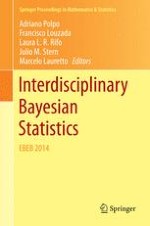2015 | OriginalPaper | Buchkapitel
4. Problems with Constructing Tests to Accept the Null Hypothesis
verfasst von : André Rogatko, Steven Piantadosi
Erschienen in: Interdisciplinary Bayesian Statistics
Aktivieren Sie unsere intelligente Suche, um passende Fachinhalte oder Patente zu finden.
Wählen Sie Textabschnitte aus um mit Künstlicher Intelligenz passenden Patente zu finden. powered by
Markieren Sie Textabschnitte, um KI-gestützt weitere passende Inhalte zu finden. powered by
